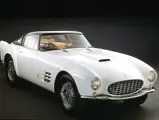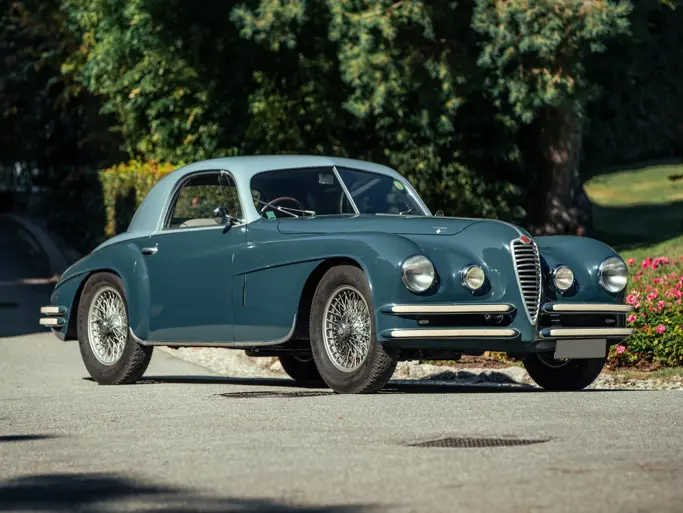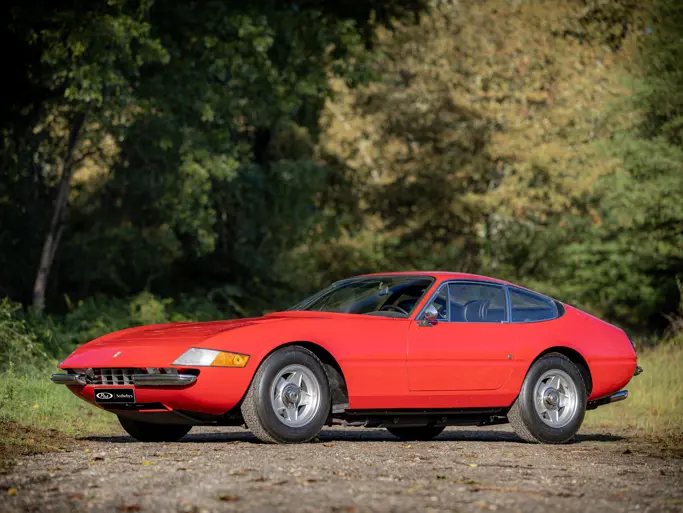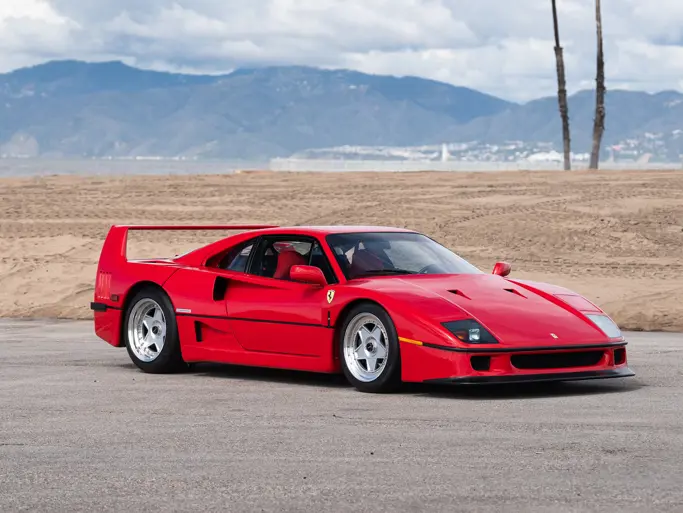Villa d'Este 2011
1955 Ferrari 375 MM Berlinetta by Pinin Farina
{{lr.item.text}}
€3,360,000 EUR | Sold
 | Cernobbio, Italy
| Cernobbio, Italy
{{internetCurrentBid}}
{{internetTimeLeft}}

340 hp, 4,522 cc SOHC V-12 engine, three Weber 42 mm DCZ/3 carburettors, four-speed manual transmission, independent front suspension by double wishbone and coil springs, rear live axle with semi-elliptic leaf springs and trailing arms, four-wheel hydraulic drum brakes. Wheelbase: 2,600 mm (102.4")
- The last 375 MM built: one-off Pinin Farina Berlinetta foreshadows the TdF
- One of only ten 375 MM Berlinettas built
- Matching-numbers
- Restored by Wayne Obry, after 30 years continuous ownership
- Shown new at Turin Motor Show (1955)
- Shown at the most exclusive events: Pebble Beach, The Quail, Cavallino Classic, Villa d’Este
- Class winner at Pebble Beach in 2004, Cavallino Classic in 2005
- Documented by Ferrari historian Marcel Massini
For about a year in 1954-55, the Ferrari 375 MM was the .44 Magnum of sports-car racing. It was deafeningly loud and had a kick like a mule. Its Formula 1 V-12 engine could blow through the opposition, driven by the likes of Jack McAfee, Jim Kimberley, Ken Miles, Masten Gregory and Carroll Shelby. Conservatively estimated at 340 horsepower and with a 180 mph top speed, a 375 demanded the highest level of driving skill – especially coming out of the corners. It remains an unforgettable experience for drivers and spectators alike.
Meanwhile, away from all the engine noise, tyre smoke and adrenaline-fuelled excitement, cooler heads in Italian design studios were defining the aggressive essence of Ferrari style – the family look that would mark the GT Berlinettas and Spyders of the future. Most of these elements appeared in the 340 and 375 Barchettas and Berlinettas, and this car, 0490 AM, is significant in that it is the very last 375 MM to be built by Pinin Farina in 1955. From here on, there would be 250 GT Ellenas and Tour de Frances, 410 Superamericas, 250 Testa Rossas and California Spyders.
In all, there were only ten 375 MM Berlinetta coupés built and 14 Barchetta spyders. They’re all slightly different (0366 AM was re-bodied by Scaglietti after an accident), but 0490 AM is the end of the line. It’s also the last even-numbered car built by Pinin Farina.
Future Ferrari styling cues that bowed on 0490 AM include front fender vents (which would be widely copied) and a lower grille with a flatter top, which projected in the style of the upcoming 1958 250 Testa Rossa and evolved into the 1965 275 GTB. 0490 AM also features rear window louvers, which would appear in the 250 GT TdF model, and headlights without bezels, which were continued on other models. One feature 0490 AM does not share with its siblings is the exaggerated rear-fender treatment.
Provenance
The history of 0490 AM is recorded in detail by Ferrari expert Marcel Massini. It is notable in that while the car was never raced, it was fortunately spared the extensive rebuilds that so often accompany an exciting past in motorsport.
Mechanical work on 0490 AM continued at the Ferrari factory throughout December 1954 until the 22nd, when the chassis was completed following completion of the engine, gearbox and rear axle. On 10 March, the chassis arrived at Pinin Farina to be bodied by the expert coachbuilder. The completed car was displayed on the Ferrari stand at the 27th Turin Motor Show from 21 April to 1 May, 1955, next to a grey 250 Europa GT coupé, 0379 GT.
The car was returned to Pinin Farina after the show for a significant number of detail modifications, as documented by Mr. Massini:
• Small separate radiator access door with a lock was built into the hood in front of the air intake.
• Chromed strip added on top of the hood scoop.
• Oval rear mirror was removed from the dashboard and a rectangular mirror attached to the roof instead.
• Side windows were replaced by sliding windows.
• Bakelite shift knob was replaced by a metal one.
• Outside fuel filler cap was fitted with a lock.
• Spears on side vents removed.
• Glove box added.
• Ashtray added.
• A medal of St. Christopher, the patron saint of travellers, added to the transmission tunnel.
• Leather straps on bonnet replaced.
• Chrome strip on side window modified.
• Possible repaint from ivory to silver gray metallic.
On 3 November, the date was engraved on the car’s Sekurit windshield, and before the end of the year it was in the hands of its first owner, Ferrari dealer and race driver Inico Bernabei, in Rome. He resold it, apparently quite soon after and most probably to Count Antonio Naselli of Trevinano di Acquapendente in Tuscany, about 80 miles north of Rome.
Naselli didn’t keep it long; 0490 AM was exported to the U.S. in 1960 and sold to Luigi Chinetti Motors in New York City. Chinetti repainted the Berlinetta in Rossa Corsa and sold it to Ed Weschler of Natosha, Wisconsin through Augie Pabst in Milwaukee. Weschler paid $8,000, an undoubted bargain.
Weschler registered 0490 AM as Q32 502 in Wisconsin in 1961 and kept it until the late 1960s, attending a Ferrari meeting at Road America at Elkhart Lake in that time. He sold it to Carl De Bickero, of Palos Heights, Illinois, who repainted 0490 AM red with a black roof and registered it on 1970 Illinois plates 715 166. On 23-25 April, 1970, De Bickero showed 0490 AM at the 9th Annual Ferrari Club of America Annual Meeting in Chicago and won the trophy for the shortest distance driven – certainly a tongue-in-cheek award.
De Bickero showed the car again at the regional Ferrari Club of America meet at Lawrence Knaack’s home in Long Grove, Illinois on 22 August, 1971, but in 1972 De Bickero sold 0490 AM to Lawrence Slattery of Chicago, who already owned a 330 GT 2+2.
Slattery certainly loved 0490 AM, because he kept it for 30 years, though there’s little evidence of him showing the car, except for on 26-28 August, 1977, when he turned up at the Ferrari Club of America Central States Region Concours and Track Event at Blackhawk Farm Race Track in Rockford, Illinois. Slattery advertised 0490 AM in October 2002, showing just 20,990 kilometres.
Restoration and Awards
In November 2002, noted collector Manuel Del Arroz of Diablo, California bought 0490 AM before it was featured in the Japanese magazine Scuderia (#43) and then shipped to Wayne Obry’s Motion Products Inc. in Neenah, Wisconsin.
0490 AM was featured before restoration in the April-May 2003 Cavallino (#134). In the course of the following year it was completely restored, and in 2004 the car was registered on California black plates as 168 RZH.
It was immediately entered in the 54th Pebble Beach Concours d’Elegance in Monterey, California on 15 August in Class M-2 Ferrari Speciale, which it won, scoring 100 points. Two days later it was shown at nearby Quail Lodge in Carmel Valley, at the 40th Annual Ferrari Club of America National Meeting. It received a Platinum Award and also the Luigi Chinetti award for the most outstanding Ferrari road car.
On 22 January, 2005, 0490 AM was shown at the Cavallino Classic at The Breakers in Palm Beach, Florida and won the Grand Turismo Cup and Best of Show GT Ferrari.
Up to this point, the string of awards was simply stunning – the very best and most desirable honours a Ferrari or any other collector car could hope to secure. Nevertheless, looking further afield, del Arroz shipped the car to Zurich, Switzerland on 1 April, 2005, where it was examined by FIVA steward Dominik Fischlin on 9 April and awarded its papers.
Manuel del Arroz next took 0490 AM to the Concorso d’Eleganza at Villa d’Este, at Lake Como, Italy on 22-24 April, 2005. The car placed 2nd in Class for Closed Cars 1940-59, directly behind another Obry restoration, the 250 GT Europa 0403, with coachwork similar to that of the ex-Roberto Rossellini 375 MM.
The car then returned to Chicago and was featured as the cover car in the U.S. Cavallino magazine (#148), the August/September issue. Little was heard of 0490 AM for several years until it was sold to UK exotics dealer Martin Chisholm in January 2010. Chisholm subsequently lent 0490 AM to preeminent European magazines Classic & Sports Car in July and Classic Driver in December 2010, and both of them wrote about it enthusiastically.
Best of the Best
As a one-off body and the last of a significant model line, 0490 AM occupies an unassailable position in the Ferrari lexicon. Its list of desirable features is virtually endless – not only did its trendsetting design foreshadow future Ferrari models, but it was the last 375 MM built. A matching-numbers car with its original motor and “no-stories” provenance, it was restored by a marque expert and documented by noted historian Marcel Massini.
It is always going to draw a crowd at any concours, and if the new owner ever feels the urge to take to the track, he will be a welcome sight and sound. All he has to worry about is braking from about 180 mph!
340 cv, motore V-12 con un albero a camme in testa di 4.522 cc, tre carburatori Weber 42 DCZ/3, cambio manuale a quattro marce, sospensione anteriore a ruote indipendenti a doppio trapezio e ammortizzatori a molla, assale posteriore rigido con balestre semi-ellittiche, freni a tamburo con comando idraulico. Passo: 2.600 mm.
- Ultima 375 MM costruita: modello unico di Pinin Farina che prefigura la linea della TdF
- Una delle sole 10 375 MM Berlinetta costruite
- Stesso numero di telaio e motore
- Restaurata da Wayne Obry, dopo 30 anni con lo stesso proprietario
- Presentata al Salone di Torino del 1955
- Esibita ai più esclusivi concorsi: Pebble Beach, The Quail, Cavallino Classic, Villa d’Este
- Vittoria di Classe a Pebble Beach nel 2004 e a Cavallino Classic nel 2005
- Ben documentata dallo storico delle Ferrari Marcel Massini
Per circa un anno, fra il 1954 e il 1955, la Ferrari 375 MM è stata la massima espressione delle vetture sport. Aveva un rombo assordante e una spinta paragonabile al calcio di un mulo. Il suo motore V12, derivato da quello della Formula 1, la faceva emergere dal lotto dei competitori e fu guidata fra gli altri da Jack McAfee, Jim Kimberley, Ken Miles, Masten Gregory e Carroll Shelby. Con una potenza stimata di 340 cv per una velocità massima di 290 km/h, la 375 richiedeva le più alte capacità di guida, specialmente in uscita dalle curve. Rimane tuttora un'indimenticabile esperienza sia l'averla guidata sia l'averla vista correre.
Comunque, al di là del rumore del motore, del fumo delle gomme e dell'adrenalinica eccitazione, i più geniali progettisti italiani stavano definendo le basi dell'aggressiva essenza dello stile Ferrari, quello spirito unico che avrebbe contraddistinto le Granturismo berlinetta e spyder del futuro. Molti di questi elementi erano presenti nelle barchette e berlinette 340 e 375, e questa vettura, telaio n. 0490 AM, è importante anche perché è stata l'ultima 375 MM carrozzata da Pinin Farina, nel 1955. Dopo ci sarebbero state le 250 GT Ellena e Tour de France, le 410 Superamerica, le 250 Testa Rossa e le California Spyder.
In tutto furono costruite solo 10 375 MM con carrozzeria berlinetta e 14 con carrozzeria barchetta sport. Erano tutte l'una leggermente diversa dall 'altra (la n.0366 AM fu ricarrozzata da Scaglietti dopo un'incidente), e la 0490 AM è l'ultima della serie. E' poi anche l'ultima vettura con numero di telaio pari carrozzata da Pinin Farina.
Fra i dettagli stilistici delle future Ferrari già presenti sulla 0490 AM possiamo notare le uscite d'aria laterali sui parafanghi anteriori (che sarebbero state copiate da molti) e una griglia più bassa con la parte superiore più lineare, che anticipa lo stile della 250 Testa Rossa del 1958 evoluto in seguito in quello della 275 GTB del 1965. La 0490 AM presenta anche le feritoie sulla parte laterale del vetro posteriore, che anticipano quelle in seguito poste sul montante posteriore della 250 GT Tour de France, e i fari senza cornice cromata, come si vedrà su altri modelli. Una particolarità unica della 0490 AM, che non condividerà con altre vetture, è l'esagerato sviluppo delle pinne dei parafanghi posteriori.
Provenienza
La storia della 0490 AM è stata ben documentata dall'esperto Ferrari, Marcel Massini. E' da notare che grazie al fatto che non è mai stata utilizzata in corsa, le sono state risparmiate tutte le riparazioni che così spesso accompagnano le vetture con una peraltro eccitante carriera agonistica.
La costruzione dei maggiori componenti meccanici della 0490 AM, iniziati nel mese di Dicembre 1954, terminarono in Ferrari il 22 dicembre con il montaggio del motore, cambio e assale posteriore. Il 10 marzo l'autotelaio arrivò alla Pinin Farina per la costruzione della carrozzeria. La vettura fu esposta dal 21 aprile al 1 maggio 1955 allo stand Ferrari al Salone dell'Auto di Torino, affiancata ad una 250 Europa GT coupé grigia, numero di telaio 0379 GT.
Come ben documentato da Marcel Massini, dopo il Salone la vettura fu riportata alla Pinin Farina per una serie di modifiche:
• Un piccolo sportello, con serratura, di accesso al radiatore fu aperto sul cofano davanti alla presa d'aria
• Una modanatura cromata fu aggiunta sulla presa d'aria sul cofano
• L’originale specchietto retrovisore ovale venne tolto dal cruscotto e ne fu montato uno rettangolare in alto con attacco sul padiglione
• Sulle porte furono montati vetri scorrevoli
• Il pomello cambio in bachelite fu sostituito con uno in metallo
• Il tappo esterno del serbatoio fu dotato di serratura
• Furono eliminate le modanature sulle uscite d'aria laterali
• Fu aggiunto un cassetto porta-oggetti
• Fu aggiunto il posacenere
• Sul tunnel della trasmissione fu fissato un ricordo di San Cristoforo, il protettore dei viaggiatori
• Furono sostituite le cinghie in pelle sul cofano
• Furono modificate le modanature cromate dei finestrini
• Probabilmente fu cambiato il colore della carrozzeria da avorio a grigio-argento metallizzato.
Il 3 novembre fu stampata la data sul parabrezza di sicurezza Sekurit e, prima della fine dell'anno, la vettura fu consegnata al suo primo proprietario, il concessionario Ferrari e pilota Inico Bernabei di Roma. Sembra che quasi subito questi la rivendette al Conte Antonio Naselli, di Trevinano di Acquapendente in Toscana, a circa 130 km a nord di Roma.
Naselli non la tenne a lungo, e la 0490 AM fu esportata negli USA nel 1960 e venduta alla Luigi Chinetti Motors di New York. Chinetti riverniciò la Berlinetta in rosso corsa e la vendette a Ed Weschler di Natosha in Wisconsin, tramite Augie Pabst, di Milwaukee. Weschler la pagò 8.000 dollari, sicuramente un affare.
Nel 1961 Weschler immatricolò la 0490 AM nel Wisconsin, con targa Q32 502, e la tenne fino alla fine degli anni Sessanta, partecipando in quel periodo ad un Ferrari meeting al Road America a Elkhart Lake. In seguito la vendette a Carl De Bickero, di Palos Heights in Illinois, che la riverniciò in rosso con tetto nero e la reimmatricolò in Illinois con targa 715 166. Dal 23 al 25 aprile 1970, De Bickero esibì la 0490 AM al 9° meeting annuale del Ferrari Club of America a Chicago, vincendo il trofeo per la vettura che aveva percorso la distanza più breve – un premio evidentemente ironico.
Il 22 agosto 1971, De Bickero esibì la vettura al meeting regionale del Ferrari Club of America a casa di Lawrence Knaack a Long Grove in Illinois, e nel 1972 la vendette a Lawrence Slattery di Chicago, già proprietario di una 330 GT 2+2.
Sicuramente a Slattery piaceva molto la 0490 AM, visto che la tenne per 30 anni; non ci sono molte tracce di partecipazioni a eventi, a parte il Concorso e la riunione in pista del Central States Region organizzato dal Ferrari Club of America al Blackhawk Farm Race Track a Rockford in Illinois, dal 26 al 28 Agosto del 1977. Slattery mise in vendita la 0490 AM nell'ottobre 2002: la vettura aveva percorso appena 20.990 chilometri.
Restauro e Premi
Nel novembre del 2002, prima che alla vettura fosse dedicato un articolo sul numero 43 della rivista giapponese Scuderia, il noto collezionista Manuel Del Arroz di Diablo, California, acquistò la 0490 AM e la inviò alla Motion Products Inc. di Wayne Obry, a Neenah nel Wisconsin.
Nel corso dell'anno successivo, la 0490 AM fu sottoposta ad un restauro totale: venne fotografata, prima del restauro, sul numero 134 (Aprile-Maggio 2003) della rivista Cavallino. Il restauro fu completato nell'agosto del 2004, e la vettura fu immatricolata in California, con targa nera da collezione 168 RZH.
Il 15 agosto del 2004 partecipò alla 54ma edizione del Concorso d’Eleganza di Pebble Beach in California, nella Classe M-2 Ferrari Speciali, che vinse ottenendo 100 punti. Due giorni dopo fu esibita al Quail Lodge, nella Carmel Valley, alla 40ma edizione del meeting nazionale del Ferrari Club of America. Ricevette la Targa Platino e il Premio Luigi Chinetti come la più eccezionale Ferrari stradale.
Il 22 gennaio 2005, fu esibita al Cavallino Classic al The Breakers a Palm Beach in Florida, dove vinse la Coppa Gran Turismo e il Best of Show per le Ferrari GT.
Già a questo punto la sequenza di premi conquistati era assolutamente straordinaria, quanto di meglio una Ferrari o una qualsiasi altra vettura da collezione potesse sperare di conseguire. Nonostante ciò, desiderando ancora di più, il 1 aprile 2005 Del Arroz mandò la vettura a Zurigo, in Svizzera, per farla esaminare dal delegato FIVA, Dominik Fischlin che il 9 aprile emise il passaporto.
Dal 22 al 24 aprile 2005, Manuel Del Arroz presentò la 0490 AM al Concorso d’Eleganza di Villa d’Este, sul Lago di Como, dove la vettura si piazzò seconda nella Classe Vetture Chiuse 1940-1959, alle spalle di un'altra Ferrari restaurata da Obry, la 250 GT Europa telaio 0403, dotata di una carrozzeria simile a quella creata all'epoca per la 375 MM di Roberto Rossellini.
La 0490 AM ritornò quindi a Chicago e le fu dedicata la copertina del numero 148 (Agosto-Settembre) della rivista americana Cavallino. Per qualche anno si è saputo poco della vettura, fino al gennaio 2010 quando fu venduta al commerciante inglese di auto da collezione Martin Chisholm, che in seguito la prestò alle importanti riviste inglesi Classic & Sports Car, in luglio, e Classic Driver in dicembre, ognuna delle quali scrisse entusiastici articoli su di lei.
Il Meglio del Meglio
Sia per la sua carrozzeria unica sia per il fatto di essere l'ultimo esemplare costruito di un modello particolarmente significativo, la 0490 AM occupa una posizione di primo piano nella storia Ferrari. L'elenco delle sue desiderabili particolarità è virtualmente senza fine, non solo la sua linea ha tracciato il sentiero per i futuri modelli Ferrari, ma è anche l'ultima 375 MM costruita. Non solo è una vettura ancora dotata del suo motore originale, che porta lo stesso numero del telaio, e con una storia priva di dubbi, ma è anche stata restaurata da un esperto della marca ed è accompagnata da un dossier compilato dal noto storico Marcel Massini.
E' sempre in grado di attirare l'attenzione del pubblico ad ogni concorso, e se il nuovo proprietario sentirà l'irresistibile desiderio di portarla in pista, sarà molto gradita sia per la vista che per l’udito. Tutto ciò a cui deve stare attento è di frenarla a quasi 290 km/h!





